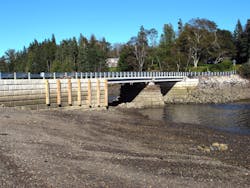Maine bridge uses first GRS wall in a marine environment
In 2013, the town of North Haven, Maine, began construction on a very unique bridge project. The goal was to rebuild a deteriorating bridge that provided access to four seasonal homes and was an important wharf for the local lobster industry.
The town faced several challenges with this project:
- North Haven is an island located on the coast of Maine; all construction materials and equipment needed to be transported to the island by boat;
- The town wanted to integrate an existing pier to minimize construction time and costs; and
- Construction in tidal conditions needed to be completed during the winter and early spring to minimize the impact on residents and fishermen.
The remote location of North Haven led the design team to search for a simpler solution than a typical pile-driven foundation for the bridge abutments. The solution was a Geosynthetic Reinforced Soil - Integrated Bridge System (GRS-IBS) using Redi-Rock as the wall-facing unit, completed as a joint effort of the town of North Haven and the Maine Department of Transportation.
“This is the first time a GRS wall has been used in a marine or tidal environment. It’s also the first time being used in a two-span bridge arrangement,” said Josh Olund, P.E., of T.Y. Lin International.
The main difference between a GRS wall and a traditional mechanically stabilized earth abutment wall is that reinforcing fabric is used in much more closely spaced layers, and the fabric is not geogrid.
“What’s typically used is more like a filter fabric. It doesn’t have the same strength as geogrid, but it’s much more closely spaced—every 6 to 9 in. versus every 18 in. with a traditional wall. This allows the fabric to act as a tension element in the soil. The facing unit isn’t really retaining the soil at all; it’s simply preventing erosion of the reinforced soil mass,” explained Jeff Benway, P.E., of SFC Engineering Partnership Inc.
Using lightweight concrete beams allowed designers to re-use an existing bridge pier to cut down on cost and time. The limestone-textured blocks matched the aesthetic look of the existing bridge pier, and fit in with the natural look of the environment.
Since the bridge abutment is partially submerged in the ocean at high tide, the blocks were cast using a low permeability concrete mix that met all Maine DOT specs. These blocks were unique in that they required flat tops and bottoms with no shear knob or groove. This custom block design allowed the geosynthetic fabric to be sandwiched between the flat blocks. The design also included intermediate, non-attached layers of Tencate Mirafi HP 770PET fabric located at mid-height of the blocks (every 9 in.).
At the tallest point, the abutment walls stand 15 ft tall, with 4 ft buried. The project included 344 total blocks, equaling 1,918 square ft.
